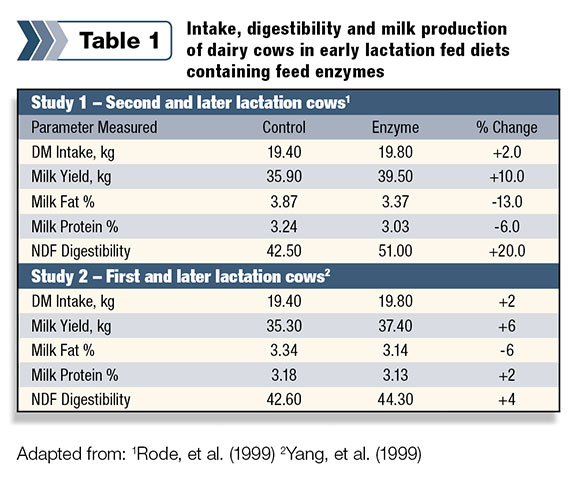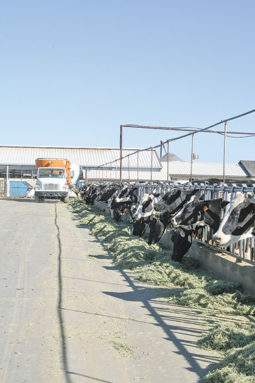In the constantly evolving dairy industry, producers and nutritionists continuously seek nutritional tools for improvement of nutrient availability. The goal is to meet the ever-increasing nutrient demand in support of the animal’s genetic potential for growth, reproduction, and of particular importance, efficient milk and component production.
Significant improvements in forage cell wall digestibility have occurred through forage breeding programs and agronomic advances.
A greater understanding of nutritional theory and practice, coupled with improved diet formulation, have also increased animal performance.
Despite these improvements, forage digestibility continues to limit the intake of available energy by high-producing dairy cows, especially those immediately post-fresh through early lactation.
When used properly, newly developed enzyme formulations can potentially help lactating cows produce more milk without more feed by improving ration component (forage and grain) digestibility. In today’s dairy industry, high feed and input costs, fluctuating milk prices and ever-tightening profit margins are the norm.
Nutritional tools, such as enzyme products, should be considered as a means of increasing pounds of milk produced per pounds of feed consumed, or income over feed cost.
A little review
Enzymes are protein molecules that catalyze specific chemical reactions. The reactions of concern are those by which feed and forage particles are broken down in the rumen to the point where they can be absorbed and utilized by the cow.
Use of enzymes in the livestock and poultry feeding industry is not new. Numerous digestive enzymes have been studied as a means to enhance animal performance. This has met with success in poultry and swine nutritional programs, where enzyme preparations are now commonly used.
Feed enzymes are concentrated extracts resulting from bacterial or fungal fermentations that have specific activities. Feeding enzymes to improve nutrient digestion in the rumen has been a topic of debate.
As proteins, enzymes could be subject to hydrolysis by microbial proteases (other enzymes which break down proteins) in the rumen or similar actions by proteases in the small intestine, where most absorption occurs.
The rumen is a very complex environment where countless reactions and interactions occur simultaneously. The exact form and combination of enzymes fed also influences their effectiveness in this dynamic system. Finally, the method of enzyme feeding also appears to play an important role.
Cattle performance when enzymes are included in the diet
Lactation responses appear to be greatest when fiber digestion is compromised, and when energy is the first-limiting nutrient in the diet. As with any additive, performance variability is common when enzyme formulations are included in the diet.
Noted variation can be attributed to experimental conditions in which energy is not the limiting nutrient, activities and characteristics of enzymes supplied, undersupplementation or oversupplementation of enzyme, inappropriate methods of providing the enzyme product to the animal and random addition of enzymes to diets without consideration for specific situations and substrate targets.
A variety of studies over the last 20 years have reported encouraging responses. One set of researchers reported that the addition of xylanase and cellulase enzyme mixtures improved the in-vitro ruminal digestion of fescue hay.

Another set reported that a rumen-stable fibrolytic enzyme supplement increased the ruminal digestion of neutral-detergent fiber (NDF) and feed nitrogen (protein source) by 23 and 5 percent, respectively.
Table 1 illustrates results of two studies, utilizing cows at different stages of lactation.
A third set of researchers applied a cellulase-xylanase enzyme mixture to the forage portion (60 percent corn silage/40 percent alfalfa hay) of a TMR.
Using a 55:45 forage:concentrate ratio, they tested an untreated control and enzyme inclusion at three levels.
Cows averaged 121 days in milk (DIM range = 38 to 204 days at experiment start). Cows fed enzyme-treated forage during the first 100 days of lactation produced 9 to 15 percent more milk and 16 to 23 percent more energy-corrected milk than cows fed the control diet.
There was no production improvement when cows were in mid-lactation at the start of the experiment. Daily income over feed costs increased $.32 to $.88 per cow per day.
Practical considerations of enzyme feeding
While the results of enzyme use continue to vary, positive responses are noted in terms of improved milk production at consistent levels of dry matter intake or consistent milk production with lowered DMIs. In either case, the net result is improved feed efficiency and improved returns over feed cost.
One particularly important consideration appears to be how the enzyme is applied or delivered. Early on, use of enzymes was restricted to their application on forages at the time of ensiling, in many cases as part of the inoculant.
This method of application has met with varying results, possibly due to the pH drop that normally occurs as part of the ensiling process. The ensiling process results in an acidic environment that can degrade or deactivate the enzyme. One method to minimize enzyme degradation by rumen bacteria is to treat feeds with enzymes just prior to feeding.
When enzymes are applied to feed in this manner, binding with substrates can cause a change in the molecular conformation that may help to protect these external enzymes from ruminal degradation.
This approach offers possibilities for using enzymes to improve nutrient digestion, utilization and productivity in ruminants, and at the same time reduce animal fecal material and pollution.
Other methods have shown positive results as well. Researchers reported that pretreatment of dry grass with fibrolytic enzymes improved ruminal fiber digestion in the lab.
Others reported that enzymes sprayed onto a grass hay and barley diet increased volatile fatty acid (energy intermediary) production and NDF digestion. Spraying enzymes on silage has increased the release of residual sugars and rate of NDF digestion.
Another consideration is feeding rate. More is not always better. Several studies have reported that high levels of enzymes resulted in lower milk yields in dairy cattle when compared to moderate levels of enzyme treatment.
Overtreatment of feeds with enzymes may result in blocking locations that might otherwise be available for microbial enzymatic digestion or may prevent attachment by rumen microbes. The need for more research in this area is obvious, but it is recommended to closely follow prescribed feeding rates.
Additionally, sources and activity of enzymes differ depending on if they are extracted from bacteria or fungi. An important consideration is to identify the exact nature of the product to be fed.
True enzymes will be listed as a “microbial fermentation product extract,” i.e. the enzymes themselves have been isolated to a large degree. Some products, also sold as enzymes, are “microbial fermentation products.”
This means that while there are generally enzymes in the mix, it is actually a blend of microbial fermentation materials which may include cells, various metabolites and some enzymes. These products are typically not as concentrated in enzyme activity.
Conclusions
Although the knowledge base is rapidly growing, we still have much to learn about the stability of added enzymes and interactions of enzymes with components of feeds. The take-home:
There are many types of enzymes that can aid in the digestive process.
1. The greatest possible benefit may be derived from those enzymes which can assist with the breakdown of fiber or fiber components.
2. Some of these enzymes include cellulase (breaks down cellulose), pectinase (breaks down pectins), fibrolytic enzymes (breaks down more general fiber particles) and xylanase (xylan).
3. The result of more extensive fiber breakdown is a greater release of energy and other nutrients.
4. Effectiveness depends on a variety of factors.
5. While much progress has been made in advancing enzyme technology for ruminants, considerable research is still required to reduce variability.
With an ever-increasing need for improved efficiency, consumer concern about the use of growth promoters and antibiotics in livestock production, and the magnitude of increased animal performance obtainable using feed enzymes, there is no doubt that these products will play an increasingly important role in the future. PD
Blezinger is a management and nutritional consultant with an office in Sulphur Springs, Texas. Email him or call him at (903) 352-3475. For more information, visit Reveille Livestock Concepts .
References omitted due to space but are available upon request. Click here to email an editor.

Steve Blezinger
Nutrition and Management Consultant
Reveille Livestock Concepts







